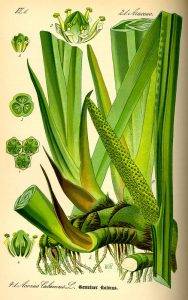Detailed description of Calamus root:
Acorus calamus Aracaea – Aracaea The medicinal callacea is a perennial plant with a stalk or rhizome growing horizontally below the ground, sprouting from year to year and producing above the ground a stalk with summer leaves and flowers, known as a capitulum. Its main stem is thick and fleshy, growing to 25-30 cm. long, and may be 1-3 cm. thick. The outer surface is uneven, jointed, greenish or pale pink and covered with brownish leaf debris. When cut in two, it is peglike and white in colour. Several thick white roots emerge from the underside. From these, which extend underground, arise the stalk with the flower-bearing stalk and the leaves with the pistil. The leaves are long, narrow, pointed, sword-shaped, 1 m high and 1-2 cm wide, with a sheath-like base which encloses the stem. The stem grows to 1.3 m. tall, almost three-edged, bearing only one terminal leaf, which forms a continuation of the stem beyond the inflorescence. At the base of this leaf, at an acute angle on the stem, is the inflorescence, 4.5-11 cm. long, green in colour and forming a small stalk. This corymbose inflorescence is composed of a thick shaft and many very small, tongue-like, undemanding flowers. These flowers are green and are so densely arranged that the shaft bearing them is so dense that a stigma is visible. The calla lily flowers in June
Occurrence:
Medical calla lily originated in the East Indies, but is now spreading in Europe, but here it grows wild because it has been cultivated in many places. It grows in lakes, ponds, marshes and quiet water banks in muddy, marshy places. It does not grow in masses in our country, only sporadically, e.g. near Cluj-Napoca, in the stagnant waters of the Great Plain and in other parts of the country. It also lives in basins and pools that are not permanently submerged, but remain dry for most of the year, as is the case at the paper mill in Cluj Napoca. As calamus root is a sought-after article and does not occur in large quantities in the wild, it is worth cultivating. Marshes, lakes and other wet and marshy places are well exploited by planting and propagating celandine there. In the spring, the old stems are cut up and laid in the muddy ground where the water can be drained off, where the water is first drained and then the corms are laid. The water should not be more than 12-15 cm above the stones at any time.
Curative effect:
The root of the calamus has a very spicy, bitter taste and a strong, succulent odour. It is very spicy and has a very pungent and pungent taste. Its mother tincture is known in medicine as rhizoma calami(radix calami aromatici). The so-called calamus root, or calamus capitulum, is used to treat stomach upsets because of its strengthening and briefly stimulating effect. It is used to make extracts, solutions, oils and spirits(extractum tinctura, oleum et spiritis calami aromatici). Calendula root, cut into pieces and boiled in sugar, is also used as a stomachic (confectio calami) (regulates stomach acid levels). Calendula is also important in the confectionery industry. It is also used to make liqueurs and, when added to brandy, to make a stomach-strengthening drink. It is also used in baths. (Side effects: currently unknown.)
Collection and harvesting:
Chickweed root should be harvested in spring, before the leaves turn green, or in late autumn. The calla lily root is usually cut with a two-branched hoe and then dragged ashore to be cleaned. The excavated corms must be cleaned of soil and silt, and the roots and leaf debris cut off. The cleaned stems are cut into smaller pieces to make them easier to dry. The corms are dried either whole and unpeeled or split or finally peeled. Peeling is used to obtain white corms, but the peeled bark can also be sold. It is not advisable to peel the calamus for domestic use, as it is the husk which contains the most volatile oil and the husk also prevents the volatile oil inside the capital from escaping. The corms are dried in an attic or drying room and the room is then heated to speed up the drying process. The must must not be dried in the sun, otherwise it will become stale. It is also not good to split it in half, as this also causes it to turn brown and lose its value. If it is so dry that it breaks easily, it can be bagged and transported. From the peeled white calla lily root, 4 kg. of fresh root are needed to produce 1 kg. of dry root. The brown root requires 4,5 kg. to produce 1 kg. dry. The peeled bark, which also requires 4 kg. to produce 1 kg. dry.
Active ingredient:
A bitter substance called acorin, essential oil, a lot of starch and mucilage, and a little tannic acid.
Cultivation:
Root stems, cut into 6-10 cm long pieces, are planted in autumn or spring in sunny, low-water soil. The plant requires 40 x 50 cm of space and 30,000 rootstocks are needed to plant one catastrophic acre. The rootstock can only be harvested in the third year. The yield per catastrophic acre is 8-10 q (hundredweight) of dry rhizome. Planting should be done in March or September.
Source:
Béla Páter, The wild herbs Dr. Ferenc Darvas and Dr. Gyula Magyary-Kossa,Domestic medicinal plants, their production, marketing, effects and medicinal uses

